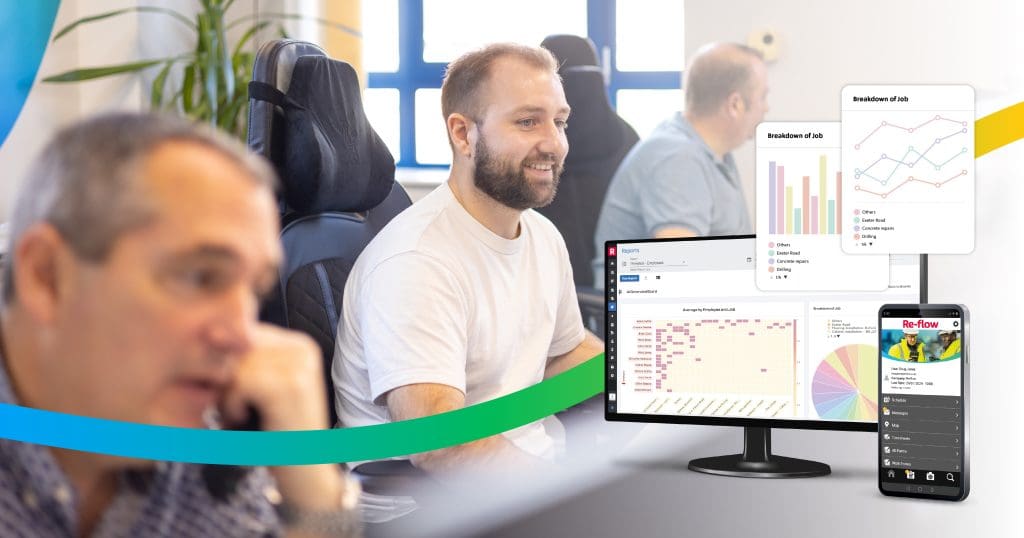
Will Brown, CFO at Re-flow, examines how choosing the right, data-driven management software could save your company millions
As the CFO of Re-flow, my job, quite simply, is to find value – not just to count it, but to create it.
In finance, we’re often seen as the gatekeepers of cost, but in growth businesses, a CFO has to be something more. We need to be a ‘chief value architect’.
We don’t just sign off budgets – we design the systems that turn every pound into ten more.
Today, the most powerful tool we have for doing that is data. Not the kind of data buried in spreadsheets, but useful, actionable data that drives decisions, creates efficiencies, and makes a measurable difference.
At Re-flow, I’m fortunate that the product we ship enables businesses to do this: to unlock value through better workflows, better data, and better insights.
Our software helps field-based organisations capture, structure, and use data in ways that directly translate into operational and financial performance.
But software is only part of the story. The rest comes from culture, behaviour, and strategy.

The £68m lesson
A look at one of the UK’s major highways providers – Amey – helps illustrate the power of data-led operations.
Amey’s highways division is a model of integrated, data-driven management. One of their analytics projects, which focused on optimising work windows for strategic roads, saved National Highways £68m on a single project.
That saving came from the carefully planned use of real-time field data.
By linking operational data (exact timings and locations of tasks) with strategic scheduling, Amey could sequence work more intelligently and eliminate wasted downtime.
It all sounds so simple, but maybe that’s the penny that still needs to drop across the sector. Carefully strategising data, giving space to it, and respecting it can transform the health of any business.
Another project in Cumbria, ‘the UK’s first carbon-neutral road improvement scheme’, cut carbon emissions by 43% and saved over £3m – simply through smarter use of materials, logistics, and data-driven planning.
By connecting operational, financial, and environmental data in one continuous thread, you are creating the blueprint of a truly modern business – one that works from an internal infrastructure that will become the norm and a keystone of success.
The cultural challenge
Of course, technology alone doesn’t deliver this transformation. The hardest part of becoming data-led isn’t installing a system – it’s building the right culture.
It might be wise to recognise common pitfalls:
- Decisions being made based on the loudest opinion, not the clearest evidence
- Strategising dictated by ‘gut feel’
Leaders need to build an environment where challenging assumptions with data is expected and rewarded. Doing this requires data literacy – not everyone needs to be a data scientist, but everyone needs to understand, question, and trust the information they use.
It’s up to business leaders to make that possible – to democratise access to data, to train people in its use, and to encourage evidence-led debate.
That’s how you move from a reactive hierarchy to an agile, data-powered organisation. That’s how you become a business taking advantage of the phenomenal opportunity provided by technology.

The first principle: fix the data
Once the cultural foundation is in place, you can focus on the data itself – and this starts with a deceptively simple question:
Are you collecting the right data, or just more data?
I’ve seen many organisations rush to build dashboards before ensuring the underlying data is clean, relevant, and complete. That’s not the way to do it.
You have to build from the ground up – identify what’s meaningful, structure your workflows to capture it correctly, and only then visualise and analyse it.
At Re-flow, we recently helped a client realise they were collecting far more data than they actually needed. Once they stripped out the unnecessary inputs, they saved over an hour of admin time per team, per day. Simplicity, focus, and precision always pay off.
From data to dividends
Overall, being truly data-led comes from embedding high-performance thinking at every level of your business. It’s about empowering teams to collect, challenge, and use their data.
The path to the £68m saving Amey achieved isn’t unique – it’s repeatable. But only when two things come together:
- A culture that values and trusts data.
- The right workflow technology to make that data visible, reliable, and actionable.
Get those two right, and the results – the savings, the sustainability, the safety – follow soon after.
That’s what we mean by ‘data to dividends’.
Discover the Re-flow return on investment
The post From data to dividends: turning information into impact appeared first on Planning, Building & Construction Today.

